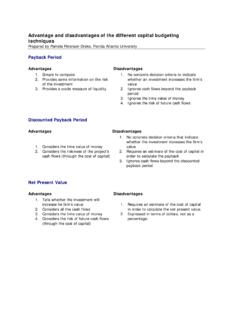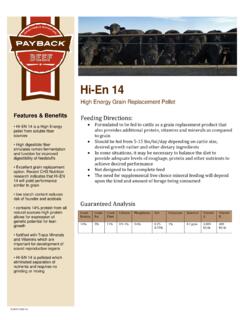Transcription of Estimating the Payback Period of Additional Insulation
1 Information from the Department of Energy Energy Efficiency and Renewable Energy April 10, 2009 Estimating the Payback Period of Additional Insulation Use the equation below to estimate the cost effectiveness of adding Insulation in terms of the "years to Payback " for savings in heating costs. Years to Payback is the time required for the Insulation to save enough fuel from heating (at present prices) to pay for itself. A simple Payback is the initial investment divided by annual savings after taxes. The equation works only for uniform sections of the home. For example, you can estimate years to Payback for a wall or several walls that have the same R-values, if you add the same amount of Insulation everywhere. Ceilings, walls, or sections of walls with different R-values must be figured separately. Subtract the areas of windows and doors when Estimating Payback for wall Insulation .
2 The cost of the energy source is also a key factor in determining Payback . Energy prices vary widely from region to region and season to season. Other factors, such as the rate of production and inventories of fuels nationwide, can also affect local energy prices. The weather from year to year also varies, so your energy costs from year to year will vary as well. To figure the cost of energy, consult your local utility for a rate schedule, or save your energy bills and plug your specific costs into this formula: Years to Payback = (C(i) R(1) R(2) E) (C(e) [R(2) - R(1)] HDD 24) To calculate the Payback , you must supply the following information: C(i) = Cost of Insulation in $/square feet. Collect Insulation cost information; include labor, equipment, and vapor barrier if needed. C(e) = Cost of energy, expressed in $/Btu.
3 To calculate the cost of energy, divide the actual price you pay per gallon of oil, kilowatt-hour (kWh) of electricity, gallon of propane, or therm (or per one hundred cubic feet [ccf]) of natural gas by the Btu content per unit of fuel. To figure the price you pay per unit, take the total amount of your bills (for electricity, propane, or natural gas) during the heating season, and divide it by the total number of gallons, kWh, or therms you consumed during those months. Use the following values for fuel Btu content: o Electricity = 3,413 Btu/kWh o Propane = 91,600 Btu/gallon o Natural Gas = 103,000 Btu/ccf or 100,000 Btu/therm E = Efficiency of the heating system. For gas, propane, and fuel oil systems this is the Annual Fuel Utilization Efficiency or AFUE. Typical AFUE values are to for oil or propane furnaces, and to for natural gas furnaces.
4 Older systems are usually less efficient. Use E = for baseboard electric systems. For heat pumps, use the Coefficient of Performance or COP for E; where E = to for conventional heat pumps, and E = to for geothermal heat pumps. R(1) = Initial R-value of section R(2) = Final R-value of section R(2) - R(1) = R-value of Additional Insulation being considered HDD = Heating degree days/year. This information can usually be obtained from your local weather station or utility. 24 = Multiplier used to convert heating degree days to heating hours (24 hours/day). Example: Suppose that you want to know how many years it will take to recover the cost of installing Additional Insulation in your attic. You are planning to increase the level of Insulation from R-19 (6-inch fiberglass batts with moisture barrier on the warm side) to R-30 by adding R-11 ( unfaced fiberglass batts).
5 You have a gas furnace with an AFUE of You also pay $ for natural gas. Let's also suppose that you supply the following values for the variables in the formula. C(i) = $ foot C(e) = ($ ) (100,000 Btu/therm) = $ E = R(1) = 19 R(2) = 30 R(2) - R(1) = 11 HDD = 7,000 By plugging the numbers into the formula, you obtain the years to Payback : Years to Payback = (C(i) R(1) R(2) E) (C(e) [R(2) - R(1)] HDD 24) Years to Payback = ( 19 30 ) ($ 11 7,000 24) = years Web resources This calculator online at: Utility incentives & tax credits SourceGas: Xcel Energy: G-NECI for propane and all-electric homes: Federal Tax Credits for Energy Efficiency









